The University of Hong Kong has set up its first all-gender toilet. However, it may serve more of a political purpose than provide convenience for those who use it.
The university’s student centre posted photos of the new facilities on their Facebook page last week. The washrooms are located on the rooftop of the campus’s main building near to the Centre of Development and Resources for Students (CEDARS).

The washrooms have a sign on the door saying All Gender Toilet – below, it reads: “This toilet is for everyone.” The sign features three figures – the traditional symbol for male and female with a transgender figure in between, in the colours of the rainbow.
However, a transgender lecturer at HKU said that she has been looking for the toilets, but hasn’t been able to find them. She has heard a lot about them, she said, but she hasn’t seen any signs on campus. HKFP also attempted to access the toilets, but was unable to do so.

“If there’s this hype going on around it there should be greater accessibility,” the lecturer said.
She says the toilets are a good first step, but they may not serve much practical use for her unless more are set up. The current location on the rooftop is way too far from her office and her classes, she said. “It’s just impractical.”
She said she has been using women’s bathrooms on campus for five years without incident, but she said she may use the all-gender ones in some cases, and at the beginning, just to make them visible.
See also: The ‘bathroom hurdle’: A transgender woman’s fight for legal recognition and safe spaces
“I identify as a woman, so I will likely not use the all gender or gender neutral toilets but I will likely use the women’s instead,” she said.

The lecturer said there should be all-gender or gender neutral toilets in every building, if not on every floor, and there should also be visible options for those who are non-gender conforming.
“I like the effort, but they should really keep going… it becomes pointless if it’s the only gender neutral toilet on the whole campus,” she said.
Political stance
Joanne Leung, chair of LGBTI advocacy group Pink Alliance, said that it’s not the first all-gender toilet in Hong Kong, as accessible toilets for disabled people and family toilets also count. But she said “within the public sphere, so openly talking about it with this attitude, this is the first.”
Leung says language is important. The toilets are called “Gender-friendly toilets” in Chinese, but they were translated to “All-Gender Toilets” in English. The term gender-friendly and the rainbow graphic denotes a political stance of supporting LGBTQ rights, she said.
However, Leung said people who are not openly transgender might be reluctant to use them because it may draw attention.
“So the function of providing convenience [for these people] may not take effect right away, but politically speaking it has a very good educational effect,” she said.
The new bathrooms and the political stance they express are good for sparking discussion, she said. For example, she says she hears from women who are wary of the concept of an all-gender bathroom, “but would they use it when there’s a line for the women’s bathroom? I think once people get used to it it’ll be fine.”
“In overseas places like the US, facilities like this have always appeared on campuses first and then influenced other public facilities,” she said.

Parental groups advocating family values have criticised the move from HKU, accusing it of using public money to promote propaganda for sexual minorities. A Facebook post by the Family School Sexual Orientation Discrimination Ordinance Concern Group took issue with the rainbow-coloured sign, saying “if these were just individual toilets built for the convenience of people with different situations and didn’t contain any brain-washing ideas, we wouldn’t oppose them.”
The sign promotes the gender spectrum – the idea that there are not only just two genders, but a continuous spectrum of possible genders, said the group. This idea is not accepted by society and conflicts with many mainstream value systems, it said in the post.
Government watchdog the Equal Opportunities Commission previously suggested setting up unisex toilets. It said the Leisure and Cultural Services department (LCSD) intended to put new signs on accessible toilets to open them to sexual minorities. However, the idea met with opposition from disability rights groups. In response, the LCSD clarified its stance, saying it will consider providing additional “universal toilets” and does not plan to alter toilets for people with disabilities.
Both Leung and the HKU academic acknowledged the work that HKU’s CEDARS has done to support the LGBT community. However, there is more that could be done, said the academic.
“HKU has done a lot for LGBT issues,” said Leung. Other universities aren’t doing a lot, so HKU is more progressive in that sense, she said.
“CEDARS claims that they provide these kinds of projects,” said the academic, “but I still don’t see enough trans or queer visibility [on campus]. Maybe we’re not doing enough, you know? Maybe we have to step back and ask ourselves: how can we fast-track the visibility of invisible voices?” she said.
